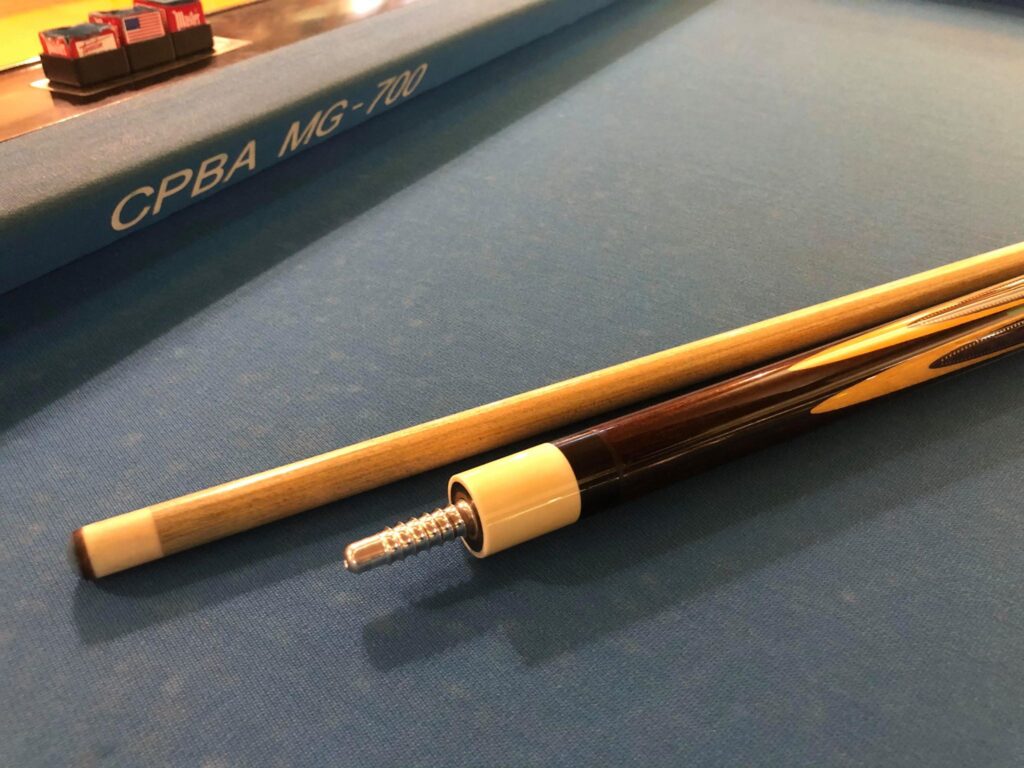The cue is now a two-piece design.
The degree of freedom in production has increased dramatically.
In this article, I’ll talk about the “parts” that make up a queue.
Originally, the cue was a single stick (one piece) that did not distinguish between the shaft and the bat, and from the late 1820s it became a two-piece design that connected the shaft and the bat with a joint, as it is now.
Naturally, the material (wood) from the end of the cue to the end of the cue is all the same.
So, for example, if you make a one-piece cue out of maple, you can’t make the back of the cue heavier because the maple itself is lighter than the other trees.
On the other hand, a two-piece can be made of many different types of wood, and the cue can be balanced in front or back.
In other words, since the cue is now a two-piece design, the degree of freedom of production has increased drastically.
Also, a bat without a hinge tends to be harder like a one-piece cue, but if the bat is made from a piece of wood like a hinge, the materials will buffer each other like a spring, making it softer and more flexible in design.
For this reason, it became mainstream to make a bat out of hagi, but there are limits to how much wood you can build.
There’s nothing you can’t do, for example, with 32 Sword Hagi.
However, the more joints you have, the weaker the bat will be, so if you put it together in such a complicated way, the bat will break when you hit it, and the performance of the tool will be compromised.
From that point of view, I think that up to about 8 sword hagi is appropriate.
Subsequently, the bat was made with a three-piece construction, consisting of a forearm, grip, and sleeve ring.
By changing the position and weight of the bolts connecting each cue, the balance of the cue itself can be changed in detail, making it easier to tune up and more flexible.
By the way, a lot of carom billiard cues have no wrapped grips or bamboo shoots with no thread winding.
That’s because Carom Billiards cues need to be sturdier, and that’s why the bat is not made of three pieces, but of wood with a core structure similar to a one-piece.
The role of the joint is.
It’s not just about connecting the bat to the shaft.
As you can see, the cue continues to evolve, and it is the joint that has played a part in it.
It doesn’t stand out among the parts of the cue, but it’s very important, and I think if the joints aren’t good, it’s hard to use them as a player, no matter how much you admire the cue design-wise.
And because queue manufacturers are aware of this, new types of joints are being developed all over the world.
A long time ago, a new type of cue was released with the thought, “If I’m going to go to so much trouble making a joint, I shouldn’t have to make a joint.
It was only when I used the “three quarter cue” that I realized that the role of the joint was more than just connecting the bat and the shaft.
The cue is slightly deflected at the joint, which makes it more finely tuned when shooting.
But that three-quarter cue has no joints, so it doesn’t deflect, so it didn’t have much of a fine-tuning effect.
It felt like the crunch of rolling a bamboo stick on the concrete.
The first cue joint I used was a brass one.
It was about 40 years ago now, but it was a substitute for a screw sold at a home improvement store, and because the accuracy was low and there was a gap in the screw, it made a clattering sound until it was fixed.
It had rusted over time and wasn’t as neat to look at as it should have been.
After using it for about two years, I used a wood jointed cue that had both male and female screws made of wood.
It had a male thread on the shaft and was very accurate, so many carom billiard players used it.
Pocket billiard cues with wood joints were also made, but in the old days, we used to break shots with play cues, so wood joints can break if you don’t play well.
So in pocket billiards, metal joints, such as brass and later stainless steel, were accepted.
However, if the joint collar is made of stainless steel, the balance of the entire cue will inevitably come to the front.
If the front of the cue is heavy, the cue tends to squat when you play, which makes it harder to push. This is why the plastic cue is not popular, especially in carom billiards.
Advances in organic synthetic chemistry have led to the creation of plastics that are as strong as metals, creating a well-balanced and solid cue.
Also, joint collars used to be made of compressed paper in the old days.
It’s like the “seat” you lay under the tip.
It was used for quite a long time, although it had some durability problems because of the high humidity that caused it to become matted.
Some people call the forward angle “knack.
The origin of the word “bony
By the way, when tips were first made nearly 200 years ago now, the tip was attached directly to the end of the cue.
But if you do that, the wood will become a whisper or split in half as you play.
So, I started to attach bones to the cue tip for protection.
That was the beginning of Sakizuno, and some people still call Sakizuno “kotsu”, which comes from the fact that it has bones.
The first was ivory, the others were whale and killer whale teeth and deer antlers.
Even when I learned to play billiards, the mainstay was the killer whale.
But the bones were susceptible to drying and could break.
Also, although ivory was superior in sound and feel, it was expensive, and with the global ban on elephant capture, plastic was used as the material for the tip of the horn, as it is now.
The leading edge of the ball will affect the feel of the ball when you hit it.
Some of them rebound slower than the tip rebound time I set and kill the performance of the tip.
However, the fact that they can be replaced relatively cheaply and easily is another feature of the first horn.
So, if the leading edge is not to your liking, it would be a good idea to have a repairer replace it.
Incidentally, in carom billiards, the exchange of first horns is quite common.
The length of the tip of the pocket billiards is about 2.5 centimeters, whereas the carom billiards are generally less than 1 centimeter.
Because of its small size and the fact that the most power is applied to the leading edge of the carom billiards, it is easy to get painful and often breaks before the shaft has reached the end of its life.
While it is difficult to accurately convey the difference in touch with words and letters, the
Once you hit the ball, you’ll understand.
The leading edge and the joint are the parts that affect the feel of the shot, but everyone has their own preferences.
Every time you hit it, you can feel it “tapping”.
And while it’s hard to tell the exact difference in feeling by words and letters, it’s easy to understand once you hit the ball.
Let’s say you have a cue that feels good to hit.
When you tell your friends how it feels and how good it is, instead of words, give them the cue and ask them to hit it, “Hey, that’s good, right? The story ends with a “Yeah, I like it.
I think that if we share our knowledge and experiences, we can communicate our senses without talking.
There’s also the joy of using a tool with a design you like, or simply the pleasure of using it.
But that’s not all.
I think that sharing the feeling of vibration and shock, which is very important in terms of performance, with others is also a way to enjoy tools.




